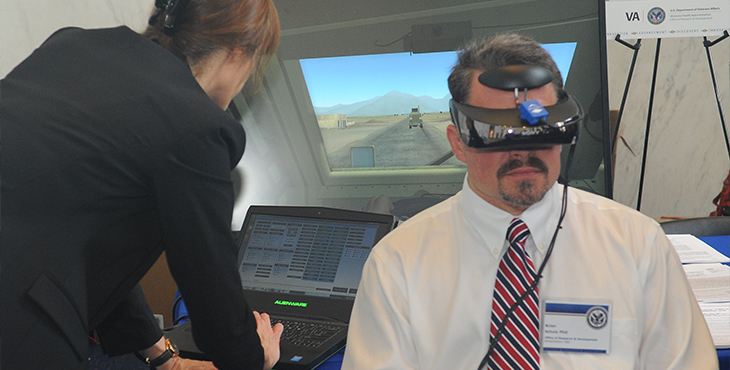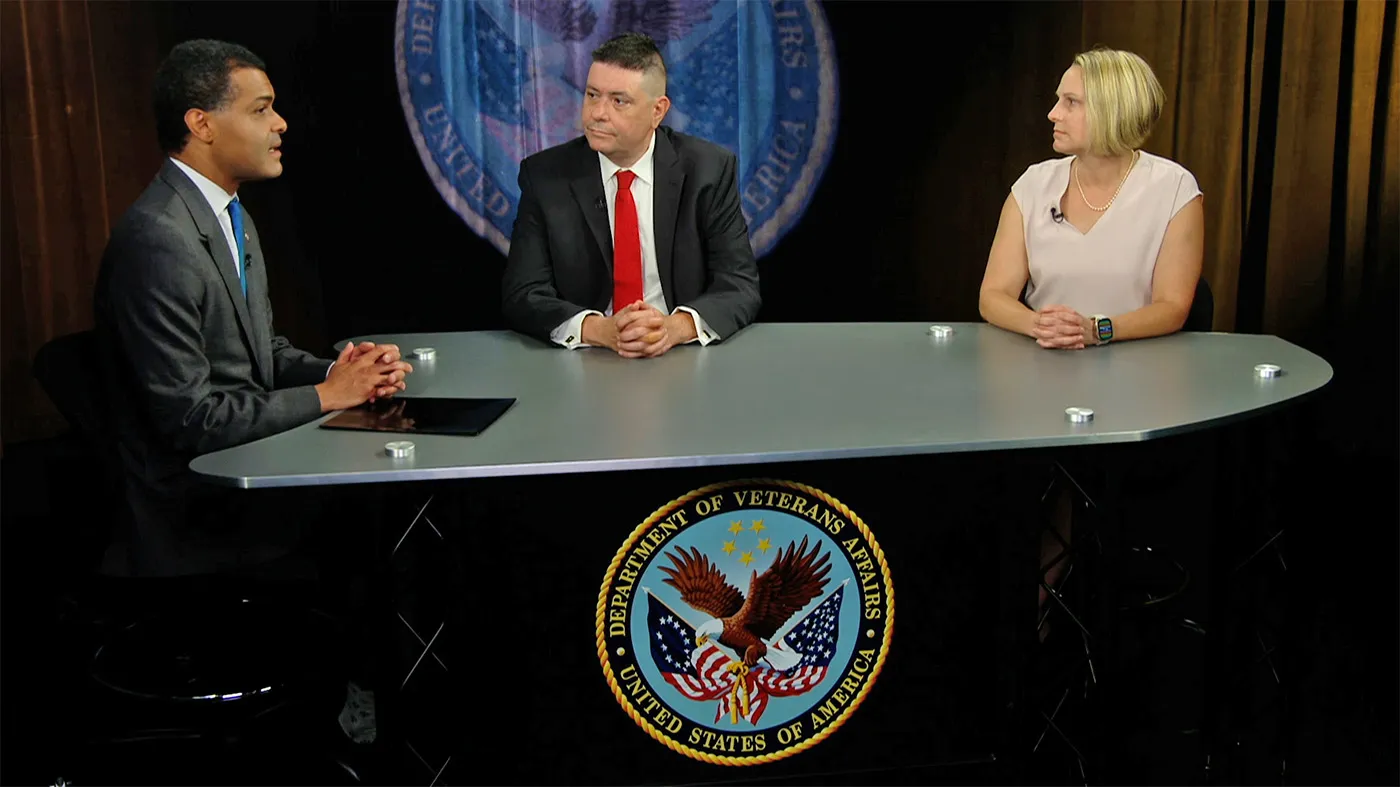Above: One brain-stimulation study at the Providence VA is testing the effectiveness of combining transcranial direct current stimulation with virtual reality, a form of prolonged exposure therapy, as a treatment for Veterans with chronic PTSD. In the photo, taken at a VA research exhibit on Capitol Hill in June 2019, a VA staffer tries on a virtual reality headset. (Photo by Robert Williams)
A VA study found that a form of brain stimulation that can rapidly improve communication between neurons in the brain helped ease PTSD symptoms.
The findings appeared online June 24, 2019, in the American Journal of Psychiatry.
The researchers, with VA’s Center for Neurorestoration and Neurotechnology in Providence, Rhode Island, used theta-burst stimulation, a relatively new form of transcranial magnetic stimulation, on 50 Veterans with chronic PTSD. Transcranial magnetic stimulation uses a magnetic coil to induce an electrical current in brain cells.
Theta-burst stimulation can be intermittent or continuous. In this case, the scientists applied it intermittently, or with breaks in the process. Doing so increases the likelihood that the neurons will be more active and will thus communicate with one another, which can potentially reduce PTSD symptoms.
The results showed that intermittent theta-burst stimulation (iTBS) “appears to be a promising new treatment for PTSD,” the researchers write. “Most clinical improvements from stimulation occurred [in the first week], which suggests a need for further investigation of optimal iTBS time course and duration.”
Dr. Noah Philip, a psychiatrist at the Providence VA Medical Center, led the study. He says this is the first time iTBS has been used on patients with PTSD. He hopes the technology will eventually replace transcranial magnetic stimulation, one of the most widely used forms of brain stimulation. A session with TMS takes about 45 minutes, compared with about 10 minutes for a theta-burst session.
A study published last year in the British journal The Lancet showed that a form of iTBS similar to the one used by Philip was just as good as standard transcranial magnetic stimulation for treating depression. The U.S. Food and Drug Administration has approved iTBS for patients with treatment-resistant depression. But the technology is only in the testing phase for treating PTSD.
“There’s some reason to think that the frequency of the theta burst stimulation may be better for people who are suffering from PTSD.”
“My interest is in Veterans with PTSD,” says Philip, who is also an associate professor at Brown University. “The Lancet study took a slightly different approach. But there’s an emerging consensus that these second-generation brain stimulation techniques like theta burst will replace what we currently have.”
In the VA study, the researchers determined after an initial 10-day treatment period that compared with sham, active iTBS “significantly improved” social and occupational function. They also found that reductions in feelings of depression and PTSD symptoms were better with active stimulation than with sham. But improvements in both categories fell short of “significant.”
“People really liked the iTBS,” Philip says. “When they got better, it was a very clear improvement. People would come to the clinic and say, `Hey, I went on a date for the first time in many years’ or `I went out with my wife or was able to go shopping.’ That occurred pretty early on near the two-week mark. Then slowly over the rest of the study we saw other positive signs. That was really nice to see.”
The researchers then offered another 10 days of unblinded iTBS treatment to all 50 participants, with the results again showing that real stimulation was better than placebo in easing depression and core PTSD symptoms and improving social and occupational function. “We had what we would call statistically significant and clinically meaningful improvement in most of the things we were looking at,” Philip says. “We also found that real stimulation reduced anger significantly in these Veterans, which we weren’t expecting.”
The side effects from iTBS, Philips notes, were consistent with those of standard transcranial magnetic stimulation. The participants felt a little bit of pain when the procedure started, sort of like a tapping or stinging sensation, and some experienced minor headaches during the stimulation period, he says. He knew of no long-term negative effects from the intermittent theta burst stimulation.
He and his team are now reviewing data to see how the Veterans are faring with their symptoms one year after receiving iTBS treatment.
Among other research, Philip’s group is also testing a combination of transcranial direct current stimulation with virtual reality, a form of prolonged exposure therapy, as a treatment for Veterans with chronic PTSD. With tDCS, a small amount of electrical current is applied to the scalp via two or more electrodes. Positive and negative currents are transmitted to the brain, making brain cells more likely or less likely to be active.
Topics in this story
More Stories
Diverse representation of women in health care research allows MVP to make discoveries for women’s health
Join the Million Veteran Program online. You will have the option to receive an at-home blood sample collection kit in the mail.
VHA's new podcast series, New Horizons in Health, features a candid discussion of psychedelic assisted therapies for Veterans experiencing mental health conditions.








I wrote about my PTSD several years ago and have gotten help to keep the road rage under control.
Before that, I had problems but meditation and therapy has helped.’
Enjoy:
Damn War To Hell & Take PTSD With It
by contoveros
Damn PTSD.
Here I am, trying to gain composure sitting in a car parked in a lot at Lee’s, a produce mart outside Conshohocken, PA. Don’t know how many customers have come and gone, seeing this middle-aged man with eyes closed silently breathing, trying to erase what he did just a few short moments ago. Actually, some 10 minutes have passed since I had “collapsed” from the latest “spike” of uncontrolled adrenalin.
I feel I just went a little “mad.” Shot out of a weapon like a bullet. Wanting to strike the nearest enemy, to do harm, to hurt some one for hurting me. I had driven reckless, tail-gating a guy who did not slow as I tried to merge into traffic as I was leaving a CVS pharmacy. He speeded up. I could have just “eaten” that slight done to me. Brush it off as just an inconsiderate gesture done in an inconsiderate world. But I was stressed-out already, and I made a federal case out of his bad behavior by making mine worse.
The post traumatic stress disorder, a.k.a., “PTSD,” kicked in. I gunned the engine, raced my car to catch up to his vehicle, coming dangerously close to his rear. He was no dummy. He applied his brakes to scare me off. I do it when someone is tailing too close to me. But, I didn’t bite, I sped up, and screeched to halt at the last possible moment, causing heads to turn by pedestrians as well as those in cars at my side and to the rear. It shook him. But not completely.
Both cars started again immediately after the near collision. I tried to see the guy, make out his features, but couldn’t. Must have been in his 20s, no more than 25. I just want to teach him a lesson about rules of the road.
There’s daylight in the passing lane. Now, I’ll slip by him . . .
And cut in front of him . . . not knowing what he may do next, because I can not look at him . . . I have to keep all of my attention on this frenzy driving. Now, I cut in front of the next car, but not as abruptly. He didn’t do anything to me. But here I am endangering everybody . . .
My God, what am I doing? Who the hell am I? What have I become?
Get away; must pull over. But not here, a little further up the road. Lee’s Fresh Produce. Pull in, Michael. Seek refuge. Seek help.
But there is none, really, is there? You’ll have this sickness the rest of your life. You should not drive. Should not deal with stress. Should be put away for your own protection . . . to protect everybody closest to you so that you won’t try to hurt anyone again. Should not have lived to come home from Vietnam. There, you finally said it. Again.
_______________________________
Therapy the next day helps. The psychologist, Dr. Howard Cohen, says there’s been improvement. That I “saw” the hole I had dug and jumped in, but was able to “get out” and look back to know exactly what the “it” was: PTSD. Some veterans believe it is “themselves” causing this bizarre behavior. That the rage they now feel is just part of their makeup. That they’re made this way, and that nothing can help them. They’re wrong, and I hope we can help them. Acknowledging that there is a problem is generally a good first step.
Damn the war. Damn the military. Damn the PTSD.
Please, my United States of America, stop all the fighting, before the fighting stops all of us.
The entire planet Earth is an EMF device. We are designed to live in magnetic fields, and suffer harm in space (where we aren’t influenced by them). We do know that some electrical fields generated by transformers are associated with increases in cancer and immune disorders as well as some of the symptoms described by Electrician Mate Kibbee. However there is no research that shows neurological or immune damage from therapeutic pulsed electromagnetic fields (to date). The use of theta-band direct stimulation applied during virtual presentation of the aversive condition is a clever way of extinguishing a neurological response to a condition (rather than using emotional extinction methods which are cruel and grueling for the participant). I applaud this innovative approach, but hope that the therapeutic benefits of pulsed electromagnetic fields in the same frequency band will be compared in clinical trials. If you’re interested in the therapeutics of pulsed electromagnetic fields, I’d suggest reading Power Tools by William Pawluk, M.D..
I am 73 years old of Vietnam vet suffering both depression and PTSD and although I’ve been in therapy for many years I do not have anywhere near the relief that your article speaks ove. I would like to know where I could go to become part of this research
As a Navy trained Electrician Mate I am not sure introducing magnetic field to brain is a good thing. Being sensitive to EMF in transformer yards I experienced nausea , skin and hair sensation etc. I’m also a former crew USS Enterprise CVN – 65. I would love to think and I hope for the sake of Veterans who suffer from PTSD and other Neuro conditions that this treatment is safe and helpful . Thomas Edison would be proud. I plan to do more research in this area. Thanks for the article. Sincerely DL Kibbee